

|
Home Updates Hydros Cars Engines Contacts Links Contact On The Wire Manufacturers Engine Test Products |

MINIATURE RACE CAR SPECIALISTS
Tethered car racing in post-war Britain experienced a huge surge of interest with new clubs and tracks appearing almost on a weekly basis. Numerous companies producing and retailing items to satisfy the ever-growing demand sprang up all around the country. Yet within 8 years virtually all of these had disappeared including the only two companies producing cars and engines for the 10cc class, 1066 Products and Rowell Motors of Dundee.
| Rowell Motors began production in 1948 but had virtually stopped trading by the end of 1952 with the final advertisements appearing early in 1953. While the products of this company are widely recorded, little is known about Rowell Motors or the man who lent his name to the engines and cars that are now rare collectors items? |
|
|
|
Wilfred George Rowell, known as Wilf, was a design engineer working on industrial cranes. Born in 1915 at Wall in Northumberland, he had served his apprenticeship with Tyne Metal Co Ltd, iron founders of Hexham. He then worked for various crane makers, Cowan Sheldon of Carlisle, Herbert Morris, and finally Coles Cranes.
Wilfred Rowell was a brilliant technical engineer, who carried his
skills over into his hobbies. His projects included building 8mm silent
and sound cine-projectors for which he
wrote an article for the ‘Model Engineer’ in June 1943, going on
to publish a book in 1948 ‘How to build your own projector’.
A measure of his design and technical skills was that he constructed a
camera, a full sized Wurlitzer Organ and a 9”screen television that he
finished just in time to watch the Coronation in 1953. |
|
He was also a skilled model
maker. In 1930 he built a large steam loco named ‘Helen of Troy’, and in
1951 this smaller gauge Class V locomotive to run round the garden of
his home, in Invergowrie, Dundee. |
|
July 47 the Model Car News carried a letter announcing the formation of the Dundee and District Model Racing Car Club the secretary being one W.G. Rowell. The first race meeting of the Club was in March 48 and the report shows that W.G. Rowell used a 10cc Hornet engined car (the engine was sent over to him by a relative in America). It also mentioned Dr. Gilbert Fraser, Wilf’s great friend and fellow car racing enthusiast, who had designed and built a twin cam racing Austin, powered by an E D diesel. Brian Sherriff, who was to become an integral part of the Rowell operation, ran a 2cc ED engined Masco Kitten. In summer 1948, adverts appeared for the Rowell ‘60’ racing engine.
|
The Mk I Rowell owed much of its design to the American Hornet and McCoy. Only the tapered cylinder and large head distinguishes it from the early McCoy 60s. With RRV induction through a Hornet type venturi and an ignition timer using standard Lucas parts the motor was far in advance of anything else being manufactured here. The Conqueror and Nordec that became commercial rivals were to follow soon after, but the Rowell had established a new benchmark in design and performance in this country. The 10cc motor could be obtained from Rowell Motors of 93, Victoria Road, Dundee. However this address as it transpires was not a factory as customers might have presumed but a model shop owned by Brian Sherriff who distributed the Rowell products. |
|
By 1949 Rowell Motors had become a limited company. The directors were Brian Sherriff, Wilfred Rowell and T Scott. With the list of components offered to the racing fraternity growing longer, an interesting question is raised as to where all these were being manufactured. Brian Sherriff had the contacts and the premises, Wilf was obviously the designer and motivator, what part T Scott played is unknown.
|
|
It is likely that Rowell Motors was not the only venture that Wilf was involved in at that time as he indicated in a letter to Gerry Buck. From the size of the company and its turnover of products, a sizable financial commitment would have been required from external sources. Model Cars of April 49 carried this front page picture of W (Bill) Armstrong of Dundee with his Rowell engined Demon. It went on to say that the car had reached 86mph using bevel gearing and a chassis which had not yet been pared of all its superfluous weight. By comparison, in July of that year Gerry Buck had achieved 100mph with ‘Topsy’, his homebuilt car and engine. |
There is a great deal of evidence to suggest that two local companies were producing components for Rowell, the Arbroath Tool and Gear Company and Kingdom Models at Coaltown of Wemyss in Fife, who built the 1cc Clan diesel motor. A canny Scotsman, cycled to Kingdom’s to buy a Clan engine direct, and reported seeing a number of Rowell engines whilst he was there. So one could reasonably assume that they assembled and tested the motors at Wemyss. What is certain is that the early engines were quite crudely sand-cast with very little attention to quality of finish or degree of fettling of the castings.
|
|
The company published a 40-page booklet in 1949 entitled ‘Miniature Race Cars their design and construction’ priced at 2 shillings. As well as providing detailed information about all aspects of building and running a tethered car it showcased the extensive range of products they were offering. However the cars illustrated include the ‘Hellcat’ and Bill Armstrong's ‘Demon’ which it was claimed were designed and built by Rowell Motors, yet they include a significant number of ZN components? In the introduction it is interesting to see the following statement, ‘that in order to provide high speed, we are compelled to offer designs and information for building cars on the American lines". Having said this they included a plan for the Rowell Rapier, which was quite unlike any other car being produced at the time. Perhaps the name Rapier and later Sabre was a humorous twist on the word ‘Dooling’, but that is mere speculation. |
All the products for sale were branded as Rowell even though they did not produce them. On the list was the Rowell 60 Mk 1 engine with spark ignition at £12 or glow plug form for £11-10-00, although no motors with plain front housings have yet come to light. Also included were an American pattern bevel gearbox, spur gear drive unit, centrifugal clutch, ‘Hot Spark’ ignition coil, direct drive flywheels and gears and a Rowell Barnard 4 volt accumulator. The Rowell driving and knife-edge type wheels and tyres offered were almost identical to the American Dooling design. A range of parts for the Rapier car completed the list.
The Rowell 60 came under intense scrutiny in 1949 from the pundits of the day. Edgar T Westbury included it in an article, and G W Arthur-Brand and Lawrence H Sparey put it under the microscope by doing test bench reports. Minor problems were identified but overall the ‘60’ was met with favourable reviews, and provided very good publicity. The ‘MCN Grand Prix Special’ was designed around the Rowell 60 engine, and the ‘Stubbs Austin’ published in the Model Car Manual suggested the motor as being suitable for high performance.
|
|
The engine came fitted with a flywheel and centrifugal clutch for cars, or a prop driver for aircraft use. In R H Warring’s book ‘Speed Control Line Models’ he compares the Rowell with the American Hornet, McCoy 60, Dooling and the British Nordec. His engine data shows the Rowell to be some 3ozs heavier than the Hornet or Dooling and 5ozs heavier than the McCoy. When the power outputs are considered an even bigger gulf is revealed with the American motors up to 50% more powerful. Although Wilf Rowell did dispute some points in the Model Cars test of his engine the fact that it produced just on 1 BHP compared with the Dooling’s 1.5 BHP could not be ignored. Certainly as this motor was intended as a rival to the Dooling it showed that there was still a great deal of development required. Its singular great advantage was that being British it was freely available, unlike the American imports. |
|
1950, and the year started with the announcement that a new Rowell Mk II engine would be ready in March at the much lower price of £9-17-6. The Mk II version featured a lightened crankcase with an enlarged transfer and rounded exhaust stack as opposed to the square Mk I. A new die-cast back-plate with a down draught venturi was the other most obvious alteration.
With a new piston now being die-cast as well, it would
indicate that more advanced foundry techniques or even a different
company were now an option for manufacture. Changes to the head and
liner completed the revision, and increased power output to a claimed 1¼ BHP. These new parts allowed customers to convert their Mk I engines,
creating a Mk I ½. |
|
The ‘Rapier’ car was available as a complete set of parts, or built to order for £29 without an engine. The ‘Rapier’ deviated from common practice in almost every aspect. Instead of a conventional chassis or pan it had solid aluminium plate side members that tapered sharply towards the nose, being joined by an aluminium casting that carried the front axle mounting. Further bracing was supplied by the engine, crank support, gearbox and tank all bolted between the plates. The body was a complex two-piece aluminium pressing. Rapier Photo's: George Blair
|
|
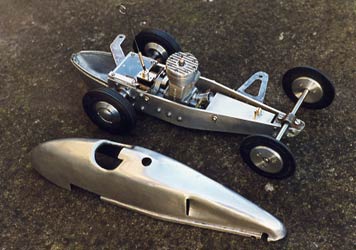 |
From the number of engines discovered so far, either with or without serial numbers, it is probable that there were not more than about *400 Rowell engines in total manufactured during the life of the company. A few were used for aircraft and tethered boats, but most found their way into tethered cars. Joe Riding of Bolton used one of these motors in his cars for much of his competitive career and to this day holds the record for the fastest speed ever recorded with a commercial British engine at 115.83mph set in 1952. His engine was interesting in the fact that he bought the Mk II but found that a Mk 1 head and backplate produced optimum performance.
|
|
Gerry Buck who was a passionate supporter of British built cars and engines actively encouraged Wilf to produce an engine that could equal the imports. Later in his career Gerry successfully campaigned a Rowell Sabre car but still could not beat the Doolings or McCoys in the ‘Open’ class. A similar situation existed in the hydroplane world where the engine was never competitive. |
|
Jim Hampton fitted his hydro (above) with a Mk1 Rowell engine that he said was reliable and produced runs of about 40mph. Rowell also supported the MPBA International Regatta in 1950 but his engines were not a great success in this discipline. George Stone, who already held the British hydroplane record with his Dooling engined ‘Lady Babs II’ at 70.1mph, fitted a Rowell into his hull ‘Rodney’ in 1950 and issued a challenge to anyone that could beat him with a British engine. He eventually achieved a speed of 54.74mph, making it the fastest British engine at that time but woefully short on the speeds of the Hornets, McCoys and Dooling. Rodney appeared on eBay but without the Rowell motor. |
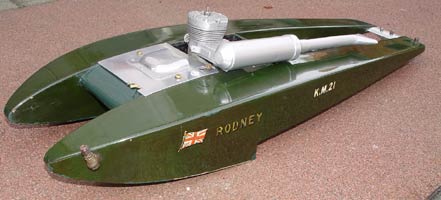 |
|
|
The ‘Model Engineer in June 1950 carried an article written by Wilf entitled ‘Ignition’ the pictures accompanying the text were of the new ‘Sabre’ car. The cast pan and general layout of the car was similar in most respects to the extremely successful Dooling Arrow. The engine appears to be the final version of the Rowell 60, the Mk II Series 2. The only feature that distinguishes the Series 2 from the Series 1 was the more steeply angled venturi that required a new back-plate with a curved intake stub. Rowell’s made a claim of 1¾ BHP at 18,000 rpm for this version. From engine numbers recorded so far, it would seem that Series 1 were numbered from 600 and Series II from 500, which is somewhat confusing. The Mk 1 appears to have serial numbers staring at 100 with 190 being the highest noted at present Photo:Ron Reiter |
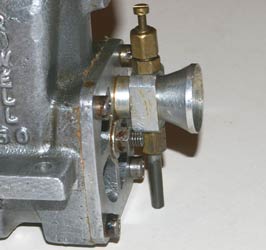 |
 |
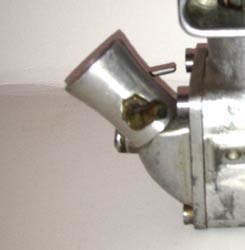 |
| Mk I | Mk II Series 1 | Mk II Series 2 |
What is obvious is that there were no adverts and there appeared to be little or no promotion for these developments. This may well be an indication that all was not well commercially at Rowell’s even at this stage. However, by perusing the race reports it becomes apparent that several people owned and raced ‘Sabres’, including of course Joe Riding, and Gerry Buck. Gerry made the trip up to Dundee in August 1950 for the Scottish Speed Championships to pick up the car, fitted with the Mk II Series 2 engine. Out of 16 entries at this meeting, the fastest Rowell was fifth at 91.9mph run by Bill Armstrong. The best performance by a Rowell at the following years Speed Championship was J Soutar who came fourth at 88.94mph running a Rowell/Sabre.
|
|
|
|
| Gerry Buck gets ready for a run at Dundee while Wilf Rowell, in trilby, looks on. | Gerry Buck's Sabre fitted with 'Grenwyn' tyres as photographed in the 1980s. | 'Works' of the Sabre fitted with MKII Series 2 motor and original Rowell wheels and tyres. |
|
Another version of the Sabre existed where the pan was given the ‘bobtail treatment, by sawing off the rear end and tether brackets, and fitting a panhandle. A longer and more streamlined body was carved to suit the newer shape. It is not known if new patterns were made for this development or if indeed it was ever marketed however in the 1952 European Championships at Monza, Carlo Davario put in a run of 156kph with a Rowell car that looked almost identical to the 'bobtail' Sabre shown. A Rowell was also seen in Italian domestic events in 1953, run by Franco Rota. Photo: Win Clarkson |
|
|
|
All these changes must
have happened in a very short space of time as it was becoming even more
evident that Rowell Motors was experiencing problems. Brian Sherriff’s shop continued to trade from the Victoria Road premises until the mid 60s when redevelopment meant that the shop moved to Cowgate in Dundee. Brian’s son, also named Brian, had the job of clearing out the shop and cellar, which still contained boxes of Rowell parts. These met their fate by being consigned to a skip. A visitor to the Cowgate shop in the early 90’s reports that his “Jaw dropped on being told that a large box of Rowell tyres had only just been thrown out”. |
|
A letter in the July 1950 issue of Model Cars, complaining about the high cost of components, which put the cars out of reach for the average enthusiast, elicited a prophetic reply from Wilf. He wrote that “Demand for racing engines and other components is relatively small in this country amounting to a few hundred people. The model car trade could not commit itself to large-scale production, although Rowell’s had produced a batch of wheels approaching four figures and that we are going to have to wait some considerable time before these are disposed of”. How right he proved to be. |
|
Wilf Rowell, like so many of his contemporaries, found that the production of models and engines for a small specialist market was not commercially viable in post-war Britain. Following the demise of Rowell Motors, he moved away from Dundee and continued working with cranes, eventually setting up his own business on the Clyde. Here he remained, until his death in November 1980.
|
|
|
|
Rapier replica, built to original Rowell plans with a Mk II motor |
Rebuilt and restored Rowell Sabre with a Mk I motor |
Overview of the Company products Dick Roberts tests the Rowell 60 below Search for Rowell items
Any article such as this is entirely dependent on the quality of the information that is available. I wish to thank and acknowledge the following for the help I have been given. Vera Rowell and her daughter, Win Clarkson. Dr Gilbert Fraser’s daughter Deirdre Hunter. Mr Farthing-Mason and Andy Hutton PR to the Dundee Club. However, most of the technical information and details of the company have been provided by the acknowledged authority on Rowell Motors, George Blair and I am indebted to him for his help and patience. Much of the groundwork in Dundee was due to the continued efforts of Thomas Deans who initiated many of the contacts as well as carrying out valuable research. Thanks also to Gill Large and Bill Langley for original photos.
*It has been very difficult to calculate
exactly how many Rowell engines were produced. It would be interesting to hear
from those who have a Rowell what the Mk and serial number is of their motor,
which could help George and I to make a more accurate estimate.
Email: otwmedia0@gmail.com
©copyrightLynBlowers2007
Rowell Engine Test
In a new departure for OTW we have a modern engine test that reflects those carried out by the likes of Sparey and Warring in the late 40's. Thanks to the late Dick Roberts and SAM 35, what follows is a detailed description and bench test of a brand new Rowell 60, no less than sixty years after it left Dundee. The article originally appeared in 'SAM Speaks' for June 2008.
|
"THE ENGINE EAR" No 7. Rowell 60 Ignition. This engine is on loan from Richard Short who has kindly (foolishly?) allowed me to run it for our enjoyment. The engine tested is the Mk1 sparkie, Serial No 150. According to information received from George Blair there are two other versions, the Mk 2 Series 1 which has an upwardly inclined carburettor, Dooling like, and extended disc pivot bearing. The other one is the Mk 2 Series 2 in which the carburettor inclination angle is increased from about 40 to 60 degrees. The Mk 1 was available either as a Sparkie or as a Glow and I would imagine that the later ones were also. No idea of how many made, but production started in 1948 and went on for some 5 years. Like a Nordec, the engine was very expensive, quoted prices being £12-00 for the basic spark engine including a KLG plug, plus 7/6 for a prop driver, £3-10 for a centrifugal clutch etc. At that time, my Father was on about £8-10 a week and considered to be "quite well off"! |
|
The engine, as can be seen in the photos, is a fairly conventional two ball bearing rear induction device, rather like a McCoy 60 on steroids. Bore is 15/16" and stroke 7/8", like the McCoy, but the whole structure is much bulkier & thus heavier, resulting in a weight of 19 ¼ ounces! From the literature, it is apparent that it was designed primarily for car use, as was the McCoy of course.
Front & rear housings, crankcase, timer frame & cylinder head are sand cast in a high grade aluminium alloy, subsequently heat treated. The engine is made to very high standards, all fits & finishes being excellent. Connecting rod is of light alloy and, rather surprisingly, is unbushed. A great deal of effort has gone into reducing crankcase volume in order to get lots of mixture through into the cylinder, but the transfer passage, like most others of the period is a bit on the small side. The liner has three transfer ports and 6 exhausts, all of moderate dimensions and there are two "boost holes" in both liner & piston to assist mixture transfer. Exhaust timing is approx 130 degrees and transfer 110 degrees, by no means "wild". Rear disc induction is open for some 170 degrees, the disc pin being well supported in the bronze bushed rear housing. Choke is 3/8" bore, with a 2mm needle across it, providing a sensible area to admit air, without the need for pressure feed.
|
|
|
The crankshaft has a fully circular web with a crescent shaped counterweight machined in and in addition, has three heavy metal slugs pressed into the web opposite the pin to improve balance.
Compression ratio is claimed to be 12 : 1, very high for the period, but no doubt aimed at using a non nitromethane fuel, a fuel component that was almost unobtainable at that time! Combustion chamber is fairly orthodox, the piston having a baffle isolating transfer from exhaust and a part spherical hump, whilst the head has matching recesses. All screw threads appear to be BSW rather than BA, presumably because that is what was available in the works!
The contact breaker incorporates a nice adjustment feature, difficult to describe, but visible I hope in the photos. The fixed point is mounted on a pressed metal bracket that rotates about the moving point pivot. It is restrained from rotating by a nut & bolt through the timer frame and a slotted hole in the bracket. Clearance is adjusted by firstly slackening off the clamp bolt & secondly by then rotating the fixed point assy slightly. The clamp bolt is then re tightened. Minor snag with this arrangement is in trying to achieve the desired .006" clearance by rotating a fairly big bracket a microscopic amount! I tried putting the feeler gauge in and then making the adjustment, but it did not work as the moving point spring is not strong enough!
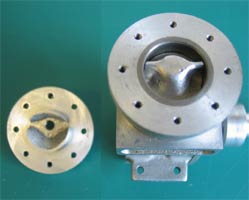 |
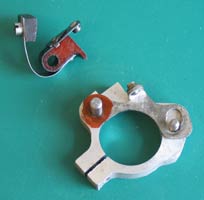 |
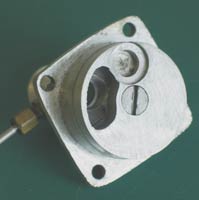 |
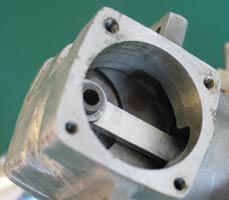 |
| Baffled piston and matching head. | Contact breaker. | Rear disc valve assembly. | Crankcase and conrod. |
Once the engine was cleaned off, lubricated & re assembled, I put it on the test stand, initially with a glow plug in order to find a needle setting. I used a 12" x 6" APC propeller and 80%/20% fuel and the engine started very nicely by hand, something of a surprise! It runs very well and the needle controls fuel mixture in a sensible fashion, being reasonably responsive.
Once I was happy that all was in order and that there were no nasty residues coming from anywhere, I set up the spark ignition system. Plug used was an NGK with a gap of 0.008" and the contact breaker gap was set at 0.006", opening 0.17" BTDC. Starting proved to be reasonably easy using the electric starter, but impracticable by hand, not really surprising with fixed ignition timing! On sparks, the engine was notably faster & smoother than on glow and felt easier to needle. The instructions do say that glow performance can be increased by the use of Nitromethane in the fuel, and presumably, like a Dooling, the spark performance can be similarly enhanced by the same means.
Vibration is notably absent, unlike some other early engines, due no doubt to the care taken to determine the counterbalance requirements. Everything stayed tight, even the mounting bolts only needing a minor tweak and no leaks anywhere.
|
|
I ran the engine on two different props, recording 10,560 RPM on the 12" APC = 0.97BHP, and 11,780 RPM on an 11" X 6" APC = 0.96 BHP. These are remarkably good figures for 1948, beating the Nordec by a mile and very close to what I understand a Black Case McCoy 60 of the period churns out! This is without any special preparation and standard fuel, with the engine almost certainly needing more running to bed it in properly. All in all a very nice engine indeed, with stacks of power, easy operation and top quality manufacture. My thanks to Richard for the loan of this excellent engine, it is very much appreciated.
R W Roberts |
Footnotes: Interestingly, the .97bhp recorded in the 2008 test confirms the figures quoted in the 1949 test. Whilst the engine is complete with box and all documentation, the serial numbers do not match, and the box indicates that it was originally for the glow version of the motor.